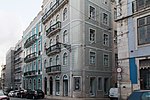Camões Monument

The Camões Monument (Portuguese: Monumento a Camões) is a monument located in Luís de Camões Square in the Chiado neighbourhood of Lisbon, Portugal. The monument comprises a tall bronze statue of Luís de Camões, the national poet, on a lioz limestone pillar surrounded by eight smaller statures of leading figures of Portuguese culture and literature in the Age of Discoveries: Fernão Lopes, Pedro Nunes, Gomes Eanes de Zurara, João de Barros, Fernão Lopes de Castanheda, Vasco Mouzinho de Quevedo, Jerónimo Corte-Real, and Francisco de Sá de Meneses. The monument was sculpted by Victor Bastos and unveiled in 1867, in the presence of King Luís I and his father, Ferdinand II.
Excerpt from the Wikipedia article Camões Monument (License: CC BY-SA 3.0, Authors, Images).Camões Monument
Praça Luís de Camões, Lisbon Misericórdia (Misericórdia)
Geographical coordinates (GPS) Address Website External links Nearby Places Show on map
Geographical coordinates (GPS)
| Latitude | Longitude |
|---|---|
| N 38.7105 ° | E -9.1434 ° |
Address
Luís de Camões
Praça Luís de Camões
1200-243 Lisbon, Misericórdia (Misericórdia)
Portugal
Open on Google Maps







